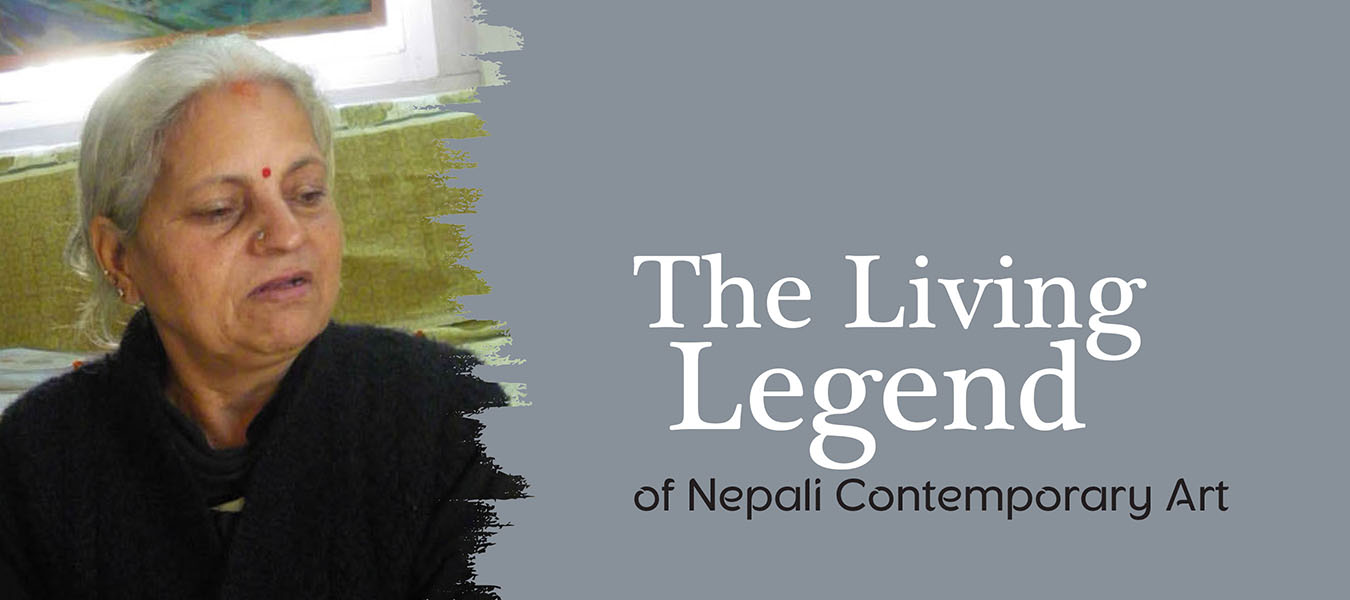Shashikala Tiwari

Shashikala Tiwari’s works deal about Hindu and Buddhist mythologies, women’s problems and the images of nature. Tiwari seems to have suffered from terrorism, tragic events and social disharmony in contemporary Nepali society, and her works depict her quest for peaceful and harmonious society. She exploits religious allegories and the images of nature to achieve this goal.
Her works carry spiritual undercurrents within them drawing her inspiration from the Hindu-Buddhist myths and allegories. Some of her her paintings explore the life of the Buddha. Shashi is also constantly seeking her inspiration from nature: the mountains and streams, trees, leaves and flowers, birds. Some of her paintings depict the images of cow and the map of Nepal. She expresses her nationalistic feeling and political comments through such images.
Some of her paintings depict the troubled, tortured and exploited female figures in the patriarchal society through the use of mythical characters, and suggest their possible rebellion against the oppressors. The combination of cool colours creates movement, rhythm and music. She develops a “distinct lyrical style” in her works with the “synthesis of literature and art”. Not only the lines and images but also the colours in her compositions are symbolic, and convey certain message. “The predominance of blue and green in her paintings is an important feature of her style. In most of her well-known canvases blue is used to mark a positive experience. Negative concepts associated with blue such as the blue mood, the dejected mind, and the world of misery, however, sometimes stand at odds with her use of colour. She nevertheless, manages to use blue as an effective symbols of nature and even of optimistic moods.
Shashikala’s paintings also depict the sub-human condition of Nepali women, their pain and anxiety and their determination to carve their own space in society. Her rebellion against social injustice unfolds gradually in the distorted visual images. Some of her women figures appear without face and recognizable shape suggesting the non-existing situation of women and their non-representation. Their identity is buried and covered with a veil. Their social status is like that of non-living things in patriarchal society though they are living human beings. They are not free to decide anything for themselves. They have been exploited as the commodity.
Denying to remain in commodified and non-existing situation, some women figures open the veil partially and attempt to gaze the dark and dominant patriarchal world in front of them. The dark abstract shapes and colours in front of them symbolically represent the violent, cruel and inhuman patriarchal society. From within the partially opened veil, they show their face suggesting that they also exist and want their place in the society. Their gaze suggests that they are not only the commodity to be exploited by males but also the agents who have the right to see the world and to decide things for themselves. However, their face in agony suggests that trying to find their place in society is a hard struggle against society. Their not yet fully recognizable semi-abstract faces suggest that they have not been able to carve her place in the society yet though they have begun their journey for the quest of their identity.
In the third stage, the distorted female figures throw away their veil, disclose their face fully and look upward. Their assertive figures suggest their potential power within them. The comparatively brighter background in front of them suggests their hope for possible independent and free life. Their distorted and expressionist figures and face suggest their anxiety, agony, pain and struggle. They have not been able to carve their space in the society yet. However, they are hopeful and determined to face the challenge and free themselves from the shackles of patriarchy. They are on the process to inscribe the identity of their being.
The images are playful and ambiguous. Tiwari discloses the dominated and suppressed condition of Nepali women, questions and resists such situation, and tries to carve the women’s space in society.
Shashikala Tiwari’s feminist compositions depict the mentally and physically wounded female figures in patriarchal Nepali society. The dripping of blood from their body represents the violence imposed upon her. The falling down of woman figures suggests Nepali women’s degenerated living condition and oppressed social status. The images of broken tree are coherent to the images of wounded female figure. Representing the gruesome situation of Nepali women, the artist questions the authority of patriarchal society.